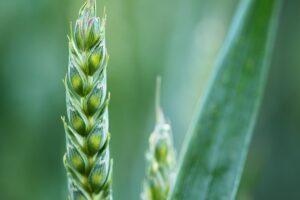The effect of high temperatures caused by climate change on the bread wheats that spread during the Green Revolution was explored
For the cover photo of the January 2024 issue of the prestigious scientific journal New Phytologist, he chose a microscopic photo illustrating the results of the staff of the Agricultural Research Institute of the HUN-REN Agricultural Science Research Center.

(Photo: Pixabay)
The researchers of the Martonvásár institute explored the effect of the so-called Reduced height or Rht genes, which are found in most modern wheat varieties and cause low stem growth, on the heat stress tolerance of bread wheat. The fertility and yield-reducing effect of the changes appearing at the level of the components of the examined cell nuclei serves as a reference point for grain breeders to create new grain varieties that are better adapted to climate change, and helps to establish the foundation of targeted breeding programs. The researchers from Martonvásár were the first to show that wheat carrying the Rht-B1b and Rht-D1b gene variants, which cause low growth – this is the majority of today’s modern wheats – respond to high temperature stress in the early period of ear development with a significant loss of fertility. The project led by senior scientific associate Adél Sepsi highlighted that meiotic cell division disorders, which are responsible for the formation of gametes, are responsible for the decrease in fertility.
In order to reveal the cause of the abnormalities, HUN-REN ATK MGI researchers used multiple immunolabeling to monitor the changes in key structural proteins during meiosis, i.e. the halving cell division that produces gametes, within the three-dimensional nucleus of bread wheat.
They were the first to show that heat stress reduces genetic diversity and the frequency of meiotic recombination, which determines fertility. According to their results, this effect is more pronounced in wheat carrying Rht genes. Using high-resolution microscopy, the researchers showed that even a short-term high temperature (30 ̊C) has an effect on chromosome pairing: during the maturation of genetic crossings, it damages the structure of the protein complex that tightly connects chromosome pairs, i.e. the synaptonemal complex. These structural changes, the decrease in the frequency of genetic crossovers and the resulting cell division abnormalities highlighted that the meiotic cell division of wheats with Rht-B1b and Rht-D1b gene variants, which cause low stem growth, is more damaged by heat than that of wheats with high growth. The fertility and yield-reducing effect of the changes appearing at the level of the components of the examined cell nuclei serves as a guide for breeders to create new varieties that are better adapted to climate change, and helps to lay the foundation for targeted breeding programs.
HUN-REN Hungarian Research Network
Related news
AM: Government helps farmers with a loan moratorium
🎧 Hallgasd a cikket: Lejátszás Szünet Folytatás Leállítás Nyelv: Auto…
Read more >More than 100 Hungarian farmers also demonstrated in Brussels
🎧 Hallgasd a cikket: Lejátszás Szünet Folytatás Leállítás Nyelv: Auto…
Read more >NAK: Domestic producers await customers with an ample supply of all pine species
🎧 Hallgasd a cikket: Lejátszás Szünet Folytatás Leállítás Nyelv: Auto…
Read more >Related news
How do young adults celebrate?
🎧 Hallgasd a cikket: Lejátszás Szünet Folytatás Leállítás Nyelv: Auto…
Read more >Vajda-Papír celebrates Ooops!’s 15th anniversary with a hybrid AI campaign
🎧 Hallgasd a cikket: Lejátszás Szünet Folytatás Leállítás Nyelv: Auto…
Read more >Pre-holiday shopping at up to half price
🎧 Hallgasd a cikket: Lejátszás Szünet Folytatás Leállítás Nyelv: Auto…
Read more >






